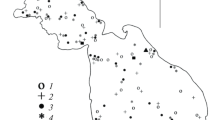Abstract
A number of lakes in Southeast Norway have developed biogenic meromixis and have typically also considerable concentrations of dissolved iron and manganese in the bottom waters. Eight such lakes are described. Products of biological decomposition like carbon dioxide, methane and some inorganic salts gave a difference in density between mixo- and monimolimnion and hence chemical stability to the lakes. The concentration of iron and manganese gave minor contributions to the density gradients, and these substances are regarded as less important for the stability because of their reduced solubility under oxic conditions.
Quantitative expressions of wind influence on lake surfaces were obtained by calculation of the work of the wind during the heating season. These values were low compared with a more exposed lake in the same region. Water movements generated by the wind have eroding effects on the chemical stratification only during short periods of homothermy before icelaying. During the rest of the year the monimolimnion is protected by either thermal stratification or ice cover. During the autumnal partial circulation a substantial reduction in chemical stability took place. For some of the lakes it is assumed that full circulation may take place in years with favourable weather conditions.
Similar content being viewed by others
References
Birge, E.A.: The work of the wind in warming a lake. Trans. Vis. Acad. Sci. Arts Lett.18, 341–391 (1916).
Boman, E.: An investigation of hydrography and primary production in Dagsjøen and Vilbergtjern, 181 p. (in Norwegian). Thesis, University of Oslo (1975).
Brunskil, G. J., and Ludlam, S. D.: Fayetteville Green Lake. New York. I. Physical and chemical limnology. Limnol. Oceanogr.14, 817–829 (1969).
Culver, D. A.: Physical, chemical and biological factors in the initiation and destruction of biogenic meromixis in a soft-water lake. Verh. int. Verein. Limnol.19, 776–783 (1975).
Culver, D. A.: Biogenic meromixis and stability in a soft-water lake. Limnol. Oceanogr.22, 667–686 (1977).
Einsele, W.: Über die Beziehung des Eisenkreislaufs zum Phosphatkreislauf im eutrophen See. Arch. Hydrobiol.29, 664–686 (1936).
Findenegg, I.: Limnologische Untersuchungen im Kärntner Seengebiet-Ein Beitrag zur Kenntnis des Stoffhaushaltes in Alpenseen. Int. Revue Hydrobiol.32, 369–423 (1935).
Findenegg, I.: Holomictische und meromictische Seen. Int. Revue Hydrobiol.35, 586–610 (1937).
Frey, D. G.: Längsee: a history of meromixis. Memorie Ist. ital. Idrobiol.8, 141–161 (1955).
Golterman, H. L.: Methods for chemical analysis of fresh waters. IBP Handbook No. 8, 172 p. Blackwell Scientific Publications, Oxford 1969.
Hansen, K.: Lake types and lake sediments. Verh. int. Verein. Limnol.14, 285–290 (1961).
Hongve, D.: Hydrographical features of Nordbytjernet, a manganese-rich meromictic lake in SE Norway. Arch. Hydrobiol.74, 227–246 (1974).
Hongve, D.: On the ecology and distribution ofChaoborus (Chaoboridae, Diptera) from the Upper Romerike District, south-east Norway. Norw. J. Ent.22, 49–57 (1976).
Hongve, D.: The ionic composition of lakes fed by ground water and precipitation in the Upper Romerike District. Nordic Hydrol.8, 141–162 (1977).
Hutchinson, G. E.: A contribution to the limnology of arid regions. Trans. Conn. Acad. Arts Sci.33, 47–132 (1937).
Hutchinson, G. E.: A treatise on limnology. I. Geography, Physics and Chemistry, 1015 p. New York and London 1957.
Kjensmo, J.: The development and some main features of ‘iron-meromictic’ soft water lakes. Arch. Hydrobiol., suppl. 32, 137–312 (1967).
Kjensmo, J.: Iron as the primary factor rendering lakes meromictic and related problems. Mitt. int. Verein. Limnol.14, 83–93 (1968).
Kjensmo, J.: Late and Post-glacial Sediments in the Small Meromictic Lake Svinsjøen. Arch. Hydrobiol.65, 125–141 (1968).
Kjensmo, J.: Postglacial sediments in Vilbergtjern, a small meromictic kettle lake. Polskie Arch. Hydrobiol.25, 207–216 (1978).
Naguib, M.: A rapid method for the quantitative estimation of dissolved methane and its application in ecological research. Arch. Hydrobiol.82, 66–73 (1978).
Nesgård, E.: An investigation of hydrography, primary production and plankton in Aurtjern, 181 p. (in Norwegian). Thesis, University of Oslo (1974).
Northcote, T. G., and Halsey, T.G.: Seasonal changes in the limnology of some meromictic lakes in southern British Columbia. J. Fish. Res. Bd Canada26, 1763–1787 (1969).
Ohle, W.: Die Stoffwechseldynamik der Seen in Abhängigkeit von der Gasausscheidung ihres Schlammes. Vom Wass.25, 127–149 (1958).
Østmo, S. R.: Hydrological map of Upper Romerike; ground water in loose deposits between Jessheim and Lake Hurdalsjøen, M. 1:20,000. Geological Survey of Norway (1976).
Østmo, S. R.: Gardermoen, quaternary geological map CQR051052-20, M. 1:20,000. Geological Survey of Norway (1976).
Perfiliev, B. V., and Gabe, D. R.: Capillary methods of investigating micro-organisms (in Russian, 1961). Transl. 1969: Oliver and Boyd.
Rebsdorf, A.: The carbon dioxide system in freshwater. Freshwater Biological Laboratory, Hillerød, Denmark 1972.
Ruttner, F.: Fundamentals of limnology, 295 p. Toronto 1963.
Walker, K. F.: The stability of meromictic lakes in central Washington. Limnol. Oceanogr.19, 209–222 (1974).
Walker, K. F., and Likens, G. E.: Meromixis and a reconsidered typology of lake circulation patterns. Verh. int. Verein. Limnol.19, 442–458 (1975).
Weimer, W. C., and Lee, G. F.: Some considerations of the chemical limnology of meromictic Lake Mary. Limnol. Oceanogr.18, 414–425 (1973).
Author information
Authors and Affiliations
Rights and permissions
About this article
Cite this article
Hongve, D. Chemical stratification and stability of meromictic lakes in the Upper Romerike district. Schweiz. Z. Hydrologie 42, 171–195 (1980). https://doi.org/10.1007/BF02502433
Received:
Issue Date:
DOI: https://doi.org/10.1007/BF02502433




